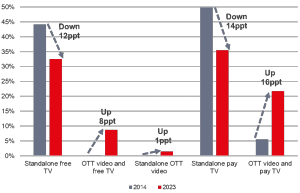Ovum: Traditional TV can fine-tune to survive but must change radically to thrive
 On a global scale, it’s clear that traditional TV services alone aren’t enough to satisfy a growing number of viewers, with audiences moving swiftly to enhance their viewing experience by subscribing to Netflix, Amazon Prime Video, or other OTT video services.
On a global scale, it’s clear that traditional TV services alone aren’t enough to satisfy a growing number of viewers, with audiences moving swiftly to enhance their viewing experience by subscribing to Netflix, Amazon Prime Video, or other OTT video services.
As recently as 2014, some 94% of households took only traditional TV – either through a free TV service, a pay-TV service, or both. That figure has now dropped below 80% and Ovum forecasts that 68% of households will take only standalone traditional TV services in 2023. In the world’s most advanced multi-subscription TV market, the US, that number has already reached 42% and is set to fall further, to 39%, in 2023.
This data comes from Ovum’s new Multi-subscription TV Forecast, which represents a completely new way of analyzing the entertainment market. By looking at the intersection of traditional TV and OTT video we have quantified, for the first time, how households will collate video services from multiple providers, both now and over the next five years.
Ovum’s new research has highlighted the extent of the challenge facing traditional TV players worldwide as their core proposition is increasingly diluted by the growing demand for additional viewing options. Some of the initial, limited, action taken by pay-TV services, like the rollout of multiscreen authentication and flexible package options, can certainly help them to minimize the rate of decline. But more radical measures are needed to ensure pay-TV companies can prosper: specifically, the business model needs to be restructured so that pay TV becomes just one of many options for audiences to purchase.
Operators and broadcasters need to position pay TV so that it is offered alongside a range of OTT, mobile, and multiplatform services that finesse packaging, bundling, and service tiering according to the mores of local audiences. This will facilitate effective segmentation of audiences with tiered services that can adapt to local market conditions. OTT options also open up new markets for the service providers by enabling rapid, low-cost expansion beyond traditional geographic footprints determined by cable or satellite network coverage.
Adam Thomas is lead analyst, Global TV Markets / Media research manager at Ovum.
Straight Talk is a weekly briefing from the desk of the Chief Research Officer.




